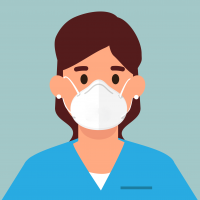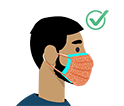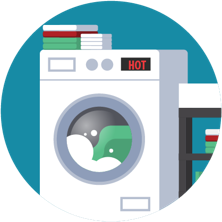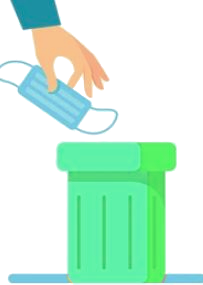Face Coverings Prevent the Spread of COVID-19
Learn about face coverings as a public protective measure against COVID-19.
Use of face covering in highly trafficked areas in indoor campus locations is recommended but not required. Please review the COVID-19 page for the most updated guidance on masks on campus.  University guidance will continue to evolve as Federal, State and County guidance is modified in response to the current public health environment.
University guidance will continue to evolve as Federal, State and County guidance is modified in response to the current public health environment.
According to the CDC, when face coverings are properly fitted over the nose and mouth, they prevent the wearer from dispersing potentially infectious aerosols and droplets into the environment where they can contaminate surfaces or be inhaled by others. Face coverings with exhalation valves (quarter-sized plastic disks on them) should not be worn as they do not protect others by preventing the dispersion of aerosols. Visit the CDC website for comprehensive mask information.
There are a variety of masks that individuals can use to protect from getting and spreading COVID-19. Choose a mask with a good fit and good filtration. A well-fitted mask has no gaps between the face and mask. Good filtration blocks virus particles from getting through the mask itself. Double masking is also an effective way to improve fit and filtration. A close-fitting cloth mask can be worn on top of a surgical/disposable mask to improve fit and filtration.
Approved masks on campus:
| Effective | More Effective | Most Effective |
|
|
|
N95 respirators:
- NIOSH approved N95 respirators filter up to 95% of particles in the air when proper fit can be achieved.
- Seal tightly to the face when fitted properly.
- Since N95 respirators form a seal to the face, they may feel harder to breathe through than a cloth mask.
- Wear a NIOSH approved N95 with a cup, flat fold, or duck bill shape, and two straps that go around the head with a formable wire nose bridge.
- Training is required for employees who choose to wear an N95-respirator voluntarily for COVID-19 protection on campus.
KN95 masks:
- Are international respirators designed to provide good filtration. (See Resources section for lab mask testing results.)
- Tend to have ear loops which often provide a worse fit than respirators with head straps (such as N95s).
- May be an effective face covering option when purchased from a reputable manufacturer and fitted to conform to the users face.
- Do not require special training before use.
- Visit the California Department of Public Health for additional information on KN95 masks.
Purchasing masks
Current campus providers of face coverings include:
- Chemistry Department Stockroom
- Campus Bookstore
- UC San Diego Core Bioservices
- PPE STORE in Oracle Procurement (search COVIDPPE)
Improve fit when wearing a mask
Reliance on a proper seal
When wearing a fitted mask, ensure that there are no gaps where the mask seals around the face. Facial hair or long beards that cross the seal of the mask can reduce its effectiveness. Use the nose wire to reduce gaps from the nose.
How to check fit
Check for gaps by cupping your hands around the outside edges of the mask. Make sure no air is flowing from the area near your eyes or from the sides of the mask.
If the mask has a good fit, you will feel warm air coming through the front of the mask and may be able to feel the mask material move in and out with each breath.
Ways to improve fit
Make sure to bend the adjustable metal nose clip to conform to your face.
Knotting and tucking: This technique can be used to improve the fit of an ear loop mask. Knot the ear loops of the mask where they join the edge of the mask, then fold and tuck the unneeded material under the edges.
Wear a cloth mask over a surgical mask to enhance fit for better protection. (CAUTION- If you wear an N95 or KN95 mask, you should not wear an additional face covering over or under the mask, as it can interfere with the seal to the face.)
Additional Facial hair considerations 
Certain types of facial hair, like beards, can make mask fitting difficult. To have a better fit, people with beards can shave their beards or trim their beards close to the face.
Other ways to improve fit: Wear one disposable mask underneath a cloth mask that has multiple layers of fabric. The second mask should push the edges of the inner mask against the face and beard.
Reduce fogging for safety glasses when using masks
Following methods can be used to reduce the fogging of the safety glasses when using face coverings and masks:
- Achieve proper seal around the nose by:
- adding nose bridge in the mask with 2 twist ties adhered with tape
- tightening the top strap when using two-strap masks
- criss-crossing the ear loops for around-ear-strap mask
- covering most of the nose area when using single strap masks
- Wash safety eyewear with mild soap and water prior to use
- Place a folded tissue paper horizontally across the nose underneath the mask
- Treat the safety eyewear with anti-fog solution or wipes prior to use
- Use anti-fogging safety eyewear
Face coverings and masks in the laboratory
If needed, laboratory workers can utilize cloth or disposable masks made of 100% cotton.
Caring for face coverings and masks
If your mask is not disposable, follow these steps.
- When soiled or dirty, wash the cloth face covering or mask using a washing machine

- The frequency of washing is dependent on the frequency of use. It is recommended that the mask be washed at least daily per CDC guidelines
- Wash items as appropriate to the cloth material or in accordance with the manufacturer’s instructions
- If possible, launder items using the warmest appropriate water setting and dry completely before storage and reuse
- Store clean cloth mask in a clean bag or container until it can be reused
- Containers used to store used or dirty mask shall be cleaned prior to reuse
If your mask is disposable, such as a surgical, KN95, or N95 mask, follow these tips.
Care and Storage:
- Do not attempt to wash disposable masks. With proper care, masks could be reusable for an extended period of time.

- To keep your disposable mask clean between uses, store your mask in a safe location that other people cannot access and where it will not get wet or be subject to direct sunlight or excessive heat. A dry paper bag works well for storage.
- When reusing, handle the mask carefully by the outer rim and avoid touching the inner surface of the mask. Wash or sanitize hands after handling.
- When removing the mask, handle by the straps and avoid touching the outer surface of the mask.
Discarding disposable mask:
- Replace KN95 when it:
- Becomes difficult to breathe through
- Becomes soiled
- No longer covers the nose and mouth
- Has stretched out or damaged ties or straps
- Cannot stay on face
- Has holes or tears in the fabric
- Is deteriorated in any way
If needed, laboratory workers can utilize cloth or disposable masks made of 100% cotton.
Resources
- Visit the COVID Safety Requirements page for the latest safety guidance.
- CDC conducted experiments to assess two ways of improving the fit of medical procedure masks